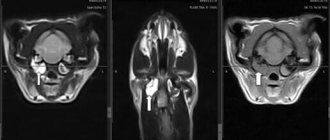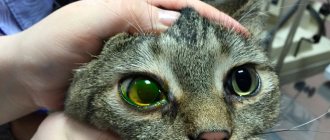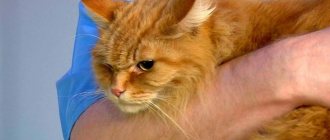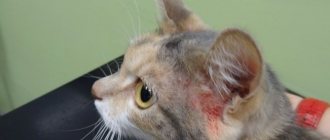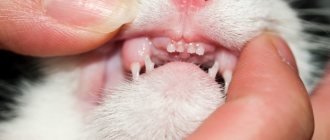The liver is one of the most important organs that helps protect against harmful substances in the cat's body, such as allergens, poisons and toxins. In some cases, the influence of negative factors is so strong that the liver cannot cope with its functions. As a result, diseases arise that require immediate treatment. In this article we will look at liver diseases in cats, their symptoms and methods of treating each of them.
Main signs of liver diseases and their types
Liver diseases in cats very often remain invisible to their owners, since signs of the disease can be confused with food allergies and bad mood. In this case, it is important to be very attentive to your pet.
Most often, cats suffer from the following liver diseases:
- Cirrhosis of the liver;
- Cholecystitis;
- Cholelithiasis;
- Hepatitis;
- Lipidosis;
- Cholangitis;
- Liver failure.
In some cases, malignant and benign tumors, amyloidosis, peliosis and other liver diseases are diagnosed.
All liver diseases can be divided into 2 types: primary and secondary.
- In primary diseases, the lesion is localized within the liver.
- Secondary liver diseases are caused by problems in the body that have nothing to do with this organ.
As a rule, liver diseases in cats have certain signs. The owner’s task is to detect the disease in a timely manner and provide quality treatment. Such actions will prevent the development of extreme stages of the disease that threaten the pet’s life.
Common signs of liver disease in cats:
- stomach disorders: vomiting and diarrhea;
- lack of appetite;
- weight loss;
- apathetic state;
- yellowing of the mucous membranes;
- change in color of stool and urine;
- severe itching;
- enlarged abdomen as a result of fluid accumulation in it;
- problems with blood clotting;
- protrusion of the liver;
- hemorrhages in the skin;
- When pressing on the area in the liver area, the cat shows severe anxiety.
The presence of one or more of the above symptoms is grounds for urgent contact with a veterinarian.
Diagnosis and treatment
It is possible to make a correct diagnosis for such diseases only in a veterinary clinic. To make a diagnosis:
- blood tests (general plus biochemical);
- stool and urine tests;
- Ultrasound, x-ray, biopsy.
Self-medication in the case of cat liver disease is fraught with serious problems, possibly even the loss of your pet. Only a doctor can determine which treatment will be most effective for the animal. The cat, depending on the diagnosis and severity of the disease, is prescribed herbal decoctions, tablets, injections, homeopathic medicines, physiotherapy to help the cat recover, as well as drugs that affect inflammatory processes. In some cases, surgical intervention is required.
Cirrhosis of the liver
Changes in the structure of the liver and overgrowth of connective tissue in it are called liver cirrhosis. This condition is characterized by loss of appetite, shortness of breath, and deterioration of heart function. The main sign of cirrhosis of the liver is an increase in its size and accumulation of fluid in the abdominal cavity of a cat. This liver disease can also be recognized by the appearance of jaundice and diarrhea, and redness of the conjunctiva.
Causes of liver cirrhosis:
- long-term intoxication of the body;
- hepatitis;
- infectious diseases caused by bacteria and viruses;
- insufficient amount of proteins and vitamins in the animal’s body.
Before starting treatment for liver cirrhosis, it is important to find out the cause of the disease. Based on these data, subsequent treatment methods are prescribed. As a rule, vitamins, diuretics, intravenous administration of salts, glucose and proteins are used to treat liver cirrhosis in cats.
To prevent this disease, it is recommended to undergo periodic veterinary examinations and feed your pet only high-quality food. The cat's heredity significantly influences the possibility of developing liver cirrhosis.
The role of the liver in cats
Passing through it, through the action of special cleansing enzymes, a completely healthy secretion of useful substances enters the blood and organs. This hardworking organ is also responsible for the synthesis of proteins and hormones, and is also a strong immune stimulant.
Most harmful substances - allergens, chemicals, various toxins from the air and food undergo thorough cleaning in the liver, causing more and more damage to it each time. Malfunctions in the work of the body’s main “cleaner” affect the functioning of vital organs, and at the same time a favorable atmosphere is created for the development of serious diseases:
- Gallstone disease;
- Cirrhosis;
- Hepatitis A;
- Cholecystitis;
- Neutrophilic and lymphocytic cholangitis;
- Lipidosis;
- Liver failure;
- Amyloidosis
Everyone knows that the liver has an amazing self-healing function, but it should be understood that the process is very long, labor-intensive and requires a professional approach. Therefore, it would be wiser not to delay at the first sign of a malfunction in the liver of cats and contact a veterinary clinic.
Every owner should remember that if their beloved pets refuse even a tasty morsel offered to them, most likely this is a manifestation of liver disease in cats, symptoms and treatment for which a certified veterinarian can recognize and prescribe.
For a more detailed understanding of the symptoms and consequences of the most common liver diseases, as well as possible treatment methods, owners will be given the information below.
Cholecystitis
Inflammation of the gallbladder (cholecystitis) occurs as a result of the formation of stones in it or the presence of giardiasis. Most often, this disease develops after a cat eats stale food contaminated with eggs and larvae of parasites, or poor quality food.
Symptoms of cholecystitis:
- elevated temperature;
- diarrhea;
- constipation;
- pain in the liver area.
To treat cholecystitis, special drugs are prescribed against microbes and parasites, as well as choleretic agents. The diet is reviewed and harmful foods are removed from the cat’s diet. The main preventive methods against the development of this disease are the use of anthelmintic drugs, timely vaccination, feeding the animal with high-quality feed and mandatory heat treatment of fish, which most often contain parasite eggs.
Cholecystitis in a cat
Cholecystitis is an inflammation of the gallbladder.
Etiology. The presence of gallstones in the gallbladder and the invasive disease giardiasis.
Clinical picture. The disease in a cat is accompanied by alternating diarrhea (diarrhea in a cat) and constipation. Increased body temperature, pain in the liver area on palpation.
The diagnosis is made by veterinary specialists based on the history, symptoms of the disease and the results of a blood test - a general analysis (including the number of platelets, leukocytes), a biochemical blood test (bilirubin, urea, glucose, creatinine, albumin, globulin, cholesterol, alkaline phosphatase, electrolytes, alanine aminotransferase ,gammaglutamyltransferase).
Treatment. Treatment of cholecystitis in a cat consists of introducing easily digestible food into the diet, antibiotic therapy, prescribing choleretic drugs, and applying a heating pad to the abdominal cavity in the liver area (prohibited during purulent processes).
Hepatitis toxic and infectious
Hepatitis is a liver disease in which the basic functions of this organ, as well as the metabolic processes of the entire body, are disrupted as a result of the breakdown of liver cells.
Depending on the causes of hepatic hepatitis, it is divided into two types:
- Toxic - caused by poisoning from the ingestion of poisons, chemicals, drug overdose, and eating harmful plants;
- Infectious – caused by viral and parasitic diseases, can develop in parallel with other diseases.
Toxic hepatitis is characterized by the following symptoms:
- loss of appetite;
- temperature increase;
- apathetic state of the animal;
- weakening of the pulse;
- difficulty breathing;
- refusal of water;
- change in urine color.
When treating this liver problem, a diet and the use of special medications to maintain immunity, antibiotics, and vitamins are prescribed. To avoid a cat getting toxic hepatitis, it is enough to avoid poisoning the animal.
Infectious hepatitis has the following symptoms:
- yellowing of the mucous membranes;
- vomit;
- constipation;
- weight loss;
- temperature increase;
- increased feeling of thirst.
The treating veterinarian prescribes antibiotics, vitamins, glucose and antispasmodics to cats with this disease. At the same time, it is not allowed to give the animal dairy and meat products or broths at the beginning of treatment. You can feed them with porridge and drink decoctions and herbal infusions.
Preventative methods against infectious hepatitis include:
- timely vaccination;
- use of anthelmintics;
- availability of fresh air;
- minimizing contact between the domestic cat and stray animals;
- feeding thermally processed or frozen food;
- use of antiparasitic drugs in the proportions specified in the instructions.
Details
Causes of liver problems in cats
Liver diseases in cats are similar in their external manifestations, but the causes of their occurrence are often different. In order not to endanger the health of your meowing pet, it is important to know the main causes of liver disease in cats:
- An inflammatory process that can penetrate from a neighboring organ through the bloodstream into the liver tissue, continue there and ultimately lead to the replacement of the organ tissue with connective tissue.
- Severe poisoning from any toxin. It doesn’t matter whether the cat inhaled household chemicals or ate some kind of poison or spoiled product. Any poisoning provokes destructive processes in the liver.
- Stones in the liver and ducts. Most often, stones form in the kidneys, but the liver sometimes gets its share of hard pebbles and sand. Most often, this process is caused by a diet with a high calcium content, incorrect or low-quality food. Also at risk are neutered cats and breeds with a genetic tendency to form stones.
- Kidney parasites - alveococcus, echinococcus, opisthorch. A cat can pick up all this fauna either from raw fish or by eating an infected mouse on the street.
- Poor nutrition, injuries in the liver area - all this most often leads to cirrhosis, but can become a provoking factor for the rest of the list of liver diseases in cats.
Symptoms of liver problems in cats
Regardless of what kind of disease has affected the liver, the symptoms of any liver failure in a cat will be similar. Such clinical manifestations include:
- Vomit. Appears due to general poisoning by toxins that the organ does not filter or remove.
- Loss of appetite. Again, this is due to the presence of unresolved toxins.
- Weight loss. Consequence of the first two symptoms.
- Intense thirst. The cat intuitively tries to cleanse its body of accumulated toxins, drinks water and partially shifts the filtering function to the kidneys.
- The stool becomes lighter.
- The urine darkens towards orange shades and acquires an odor.
- Yellowing of mucous membranes.
All this indicates problems with the liver, and the intensity of the increase in symptoms varies. If the poisoning or infection is severe, then all the symptoms will appear at once. If the disease gradually consumes the organ, the symptoms will appear gradually.
When an organ is affected seriously enough, it begins to be palpated on the surface of the body. This is a signal of a neglected condition and it is rare that such an organ can be treated.
IMPORTANT: in super-advanced cases, cats develop convulsions and immobility. The cat's body is full of toxins and cannot cope with their elimination by third-party methods.
Lipidosis
This disease occurs as a result of excessive accumulation of fat in the cells of the cat's body. Typically, lipidosis is caused by diseases such as diabetes mellitus or ulcerative colitis. Lipidosis is characterized by the accumulation of fat in the liver, causing the organ to become damaged and swollen. If this disease is not treated promptly, it can develop into kidney failure.
Symptoms of lipidosis:
- the appearance of excess weight;
- metabolic disease;
- loss of appetite.
Treatment is based on a special diet, as well as therapeutic methods prescribed by a veterinarian.
Diet and special nutrition
In addition to the medications prescribed by the veterinarian, during treatment it is necessary to follow special diets that reduce the load on the liver.
If feeding standards are observed, the animal’s pain will decrease, this will allow it to recover faster.
Pancreatitis in cats: first symptoms, nutritional nuances and treatment options (125 photos and videos)Subcutaneous mites in cats - first symptoms, treatment options and real photos of examples of parasite damage (110 photos + video)
Vomiting in a cat - the main causes, possible diseases and treatment with modern methods (105 photos)
In order to prevent the disease from progressing, elements that boost immunity and can improve the functioning of the body must be added to cat food for liver disease.
You need to include more proteins in your diet, preferably of plant origin.
If you are underweight, you need vitamins B and K. For a speedy recovery, the animal’s diet must contain sufficient amounts of carbohydrates and fats.
Despite the fact that the early symptoms of the disease are difficult to determine, if you treat your pet well, you can always manage to leave it and achieve success in treatment.
Liver failure
One of the most severe liver diseases is liver failure, which can occur in acute or chronic form. Among the main symptoms of this disease are yellowing of the mucous membranes, neuropsychiatric disorders, and hemorrhagic syndrome.
Acute liver failure is characterized by the following symptoms:
- bad breath;
- vomit;
- disorientation of consciousness;
- state of shock.
The causes of this disease can be severe poisoning and infections.
The course of the chronic form of liver failure occurs much more slowly than the acute form, so the initial symptoms may not be so pronounced. But over time, you may notice a loss of appetite, a decrease in temperature, an enlarged liver, vomiting and diarrhea. In some cases, you may notice blood in the stool.
As a rule, liver failure develops as a result of lack of treatment for certain diseases, such as diabetes mellitus or hepatosis. Older or overweight cats are at risk. The impetus for the development of the disease can be a stressful situation for the animal.
Prevention of liver disease in cats
It is easier to prevent any disease than to treat it. Therefore, be conscious about keeping a cat.
One of the largest and most important organs in the mammalian body is the liver. Scientists suggest that its functions are still not fully understood. It is the liver that is responsible for neutralizing toxins that enter the blood from the portal vein coming from the liver; it also produces many hormones. This same organ plays the role of one of the largest and most important blood depots, preventing the development of arterial collapse in the event of massive blood loss. It is not surprising that any pathology has a serious impact on the general condition of the body. An example is liver failure in cats.
Firstly, there is no such disease. This is the name of a generalized set of symptoms that are manifestations of diseases leading to deterioration of liver functionality.
Cholangitis
Hepatic cholangitis is a disease characterized by severe pain in the side, accumulation of fluid in the abdominal cavity, and cutting sensations when urinating. At the moment, it has not been possible to find out the exact causes of this liver disease. There is an opinion that the impetus may be problems with the animal’s immunity.
With cholangitis, not only the liver, but also the stomach suffers. An increase in blood pressure is also often observed. Therefore, treatment of this disease requires mandatory consultation with a veterinarian.
Disease Prevention
When it comes to preventing illness, most people mean purchasing food recommended for liver diseases, physical activity, and preventive actions against parasites. This is great, but still not enough without visits to the vet on a regular basis.
When symptoms appear, it means time has already passed. Pay more attention to your pet, stroke it more often; if the animal has no desire, do not force it out into the street.
If the animal has found a secluded place and wants to be alone, give it this opportunity.
Visit your veterinarian regularly to prevent early occurrences. If the disease does occur, the doctor will tell you what to feed a cat with liver disease.



